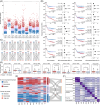Ex vivo drug responses and molecular profiles of 597 pediatric acute lymphoblastic leukemia patients
- PMID: 40727946
- PMCID: PMC12301861
- DOI: 10.1002/hem3.70176
Ex vivo drug responses and molecular profiles of 597 pediatric acute lymphoblastic leukemia patients
Erratum in
-
Correction to "Ex vivo drug responses and molecular profiles of 597 pediatric acute lymphoblastic leukemia patients".Hemasphere. 2025 Sep 18;9(9):e70221. doi: 10.1002/hem3.70221. eCollection 2025 Sep. Hemasphere. 2025. PMID: 40978274 Free PMC article.
Abstract
Ex vivo drug response profiling is emerging as a valuable tool for identifying drug resistance mechanisms and advancing precision medicine in hematological cancers. However, the functional impact of dysregulation of the epigenome and transcriptome in this context remains poorly understood. In this study, we combined ex vivo drug sensitivity profiling with transcriptomic and epigenomic analyses in diagnostic samples from 597 pediatric B-cell precursor acute lymphoblastic leukemia (BCP-ALL) patients. Ex vivo resistance to antimetabolites (e.g., cytarabine, thioguanine), glucocorticoids (e.g., dexamethasone, prednisolone), and doxorubicin was independently associated with reduced relapse-free survival (P < 0.05). Molecular profiling identified pretreatment DNA methylation and gene expression patterns distinguishing resistant from sensitive cases, revealing key drug resistance signatures. These included aberrant expression of genes related to heme metabolism (e.g., ATPV06A) and KRAS signaling (e.g., GS02). Notably, we also observed atypical expression of genes usually restricted to T cells and other immune cells (e.g., ITK) in resistant BCP-ALL cells. Our findings demonstrate that ex vivo drug response patterns are predictive of clinical outcomes and reflect intrinsic molecular states associated with drug tolerance. This integrative multi-omics approach highlights potential therapeutic targets and underscores the value of functional precision medicine in identifying treatment vulnerabilities in pediatric ALL.
© 2025 The Author(s). HemaSphere published by John Wiley & Sons Ltd on behalf of European Hematology Association.
Conflict of interest statement
The authors declare that they have no conflicts of interest.
Figures




References
LinkOut - more resources
Full Text Sources
Miscellaneous
